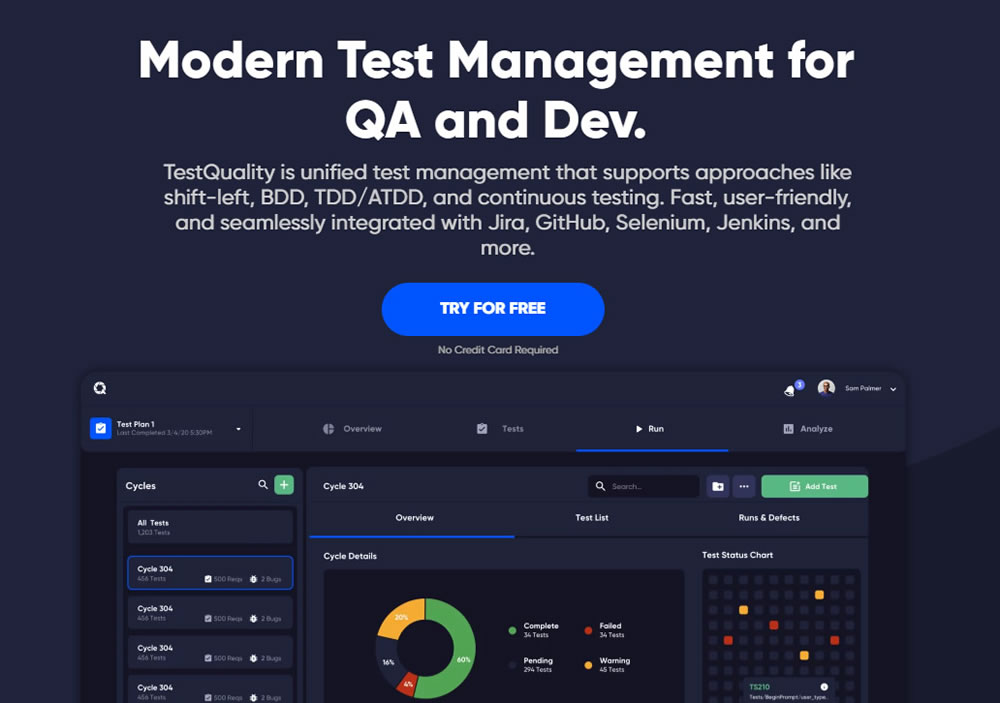Creating a robust Test Plan either on an online document or written paper, is the foundation for delivering high-quality software and it helps streamline the testing phase and serve as a starting point for further initiatives. This goes beyond ensuring functionality; it's about creating a seamless user experience (UX) that caters to your target audience. This blog post delves into strategies for prioritizing user experience, including user personas and scenarios, usability testing, and accessibility testing. Additionally, we'll explore how to achieve a balanced approach between automation and manual testing to optimize efficiency and maximize test coverage.
1. Embrace Collaboration:
- Early Stakeholder Involvement: Don't wait until the development cycle is underway. Involve stakeholders (developers, product managers, business representatives) from the outset. Their input on project goals, user needs, and potential risks will shape a more effective test plan.
- Subject Matter Expert (SME) Collaboration: Identify subject matter experts (SMEs) within the domain or technology being tested. Their knowledge can be invaluable in defining test cases, identifying edge cases, and ensuring test coverage aligns with industry best practices.
2. Prioritize User Experience:
Focusing on user experience (UX) within your test plan is crucial for building software that is not just functional, but also intuitive, enjoyable, and efficient for your target audience. Here's how to deepen your approach:
User Personas and Scenarios: Develop user personas representing different user segments and create test cases based on their expected behavior and workflows. This ensures testing caters to the diverse needs of your user base.
- Example: Develop user personas for your software, such as a "Novice User" unfamiliar with the technology, and an "Expert User" who needs advanced functionalities.
- Metrics: For each persona, create user stories and test cases that map to their typical workflows and goals. Track the completion rate of these user stories to gauge how well the software caters to different user segments.

Usability Testing: Dedicate resources to usability testing. Observe real users interacting with the software to identify areas for improvement in terms of intuitiveness, user interface (UI) clarity, and overall user experience.
- Example: Conduct usability testing sessions with a representative group of users. Observe their interactions, note any difficulties encountered, and gather feedback on the overall user interface (UI) clarity and information architecture.
- Metrics: Use metrics like task completion time, error rate, and user satisfaction surveys to measure the usability of your software. Aim for a high task completion rate with minimal errors and positive user feedback to indicate a user-friendly experience.
Accesibility Testing: In the spirit of inclusive design, accessibility testing ensures your software is usable by everyone, regardless of ability. This caters to users with visual, auditory, motor, or cognitive impairments, and aligns with ethical software development practices.
- Example: Ensure your software adheres to accessibility guidelines like WCAG (Web Content Accessibility Guidelines) to cater to users with disabilities. This may involve testing for features like screen reader compatibility, keyboard navigation, and color contrast.
- Metrics: Track the number of accessibility defects identified during testing. As you iterate and improve, strive for a reduction in these defects to ensure your software is inclusive for all users.
3. Balance Automation and Manual Testing:
- Identify Automation Opportunities: Repetitive tasks like regression testing are ideal candidates for automation. Utilize testing frameworks and tools to streamline these processes and free up tester bandwidth for more exploratory and critical testing.
- Maintain Manual Testing Focus: While automation offers efficiency gains, don't neglect the importance of manual testing. Manual testing allows testers to explore the software intuitively, identify unexpected behavior, and ensure a smooth user experience that goes beyond basic functionality.
4. Clarity and Communication:
- Clear and Concise Language: Avoid technical jargon and ambiguity. Use plain language that everyone involved in the project can understand. This fosters better communication and reduces misunderstandings.
- Maintainable Documentation: Structure your test plan in a logical and easy-to-navigate way. Utilize tables, diagrams, and clear headings for improved readability.
- Version Control: Version control systems like Git allow you to track changes made to the test plan over time. This facilitates reverting to previous versions if necessary and provides a clear audit trail for future reference.
5. Communication is Key:
- Regular Test Progress Updates: Schedule regular meetings or utilize communication channels to update stakeholders on testing progress, identified defects, and any roadblocks encountered.
- Transparent Reporting: Generate clear and concise test reports that summarize findings, defect logs, and overall test coverage. These reports should be easily accessible to stakeholders for informed decision-making.
By incorporating these key points and addressing potential pain points, you can develop a robust test plan that serves as a cornerstone for successful software development. Remember, a well-crafted test plan is not a static document; it should adapt and evolve alongside your project to ensure comprehensive testing and a high-quality final product.

Advantages of having a software test plan
A software test plan has many benefits, such as:
1. An essential part of providing effective resource management and monitoring is documenting testing. A test plan is a useful tool for this purpose.
2. The test plan is a concise outline of the testing procedure that QA engineers may follow to ensure that no features are tested that are not part of the scope.
3. Time, cost and effort estimation: The test plan assists in estimating the time, money, and effort required for the testing activities by outlining when and how to do them.
4. Description of crucial parts: The test plan describes crucial parts that may be utilized for different projects, such as the test scope, test technique, and test estimate.
5. Overview of testing activities: The test plan lays out the activities to be performed and when they should begin and end. This helps in creating a schedule for the testing activities according to the amount of time and labour required.
6. Estimation of Resources: The test plan is useful for estimating the amount of resources that will be required to complete the task.
7. Identify Solutions: A test plan dentifies solutions by encouraging team members to think about the problems with the project and how to fix them.
8. Establishes guidelines: The test plan is like a guidebook for following all the regulations when the project is finished step by step.
9. Test strategy focus: A thorough test strategy eliminates room for error by making sure every possible scenario is covered in the quest for a reliable software delivery.
10. Definition of Testing goals: The goals and extent of software testing are defined: In software testing, a well-written test plan document aids in outlining the team's goals for the process and making it clear which features, functions, and components need verification.
11. Test Plan strategy: When testing software, a test plan should lay out the methods or approaches to be used, as well as the kinds of tests that are required.
12. Test Scheduling: A solid test plan should serve as a timetable for creation of test cases, application testing, and correction of defects, among other testing operations.
13. Management of testing resources: A well-thought-out test plan accounts for the time, energy, and money needed to test software and distributes these resources sensibly.
14. Communication: A test plan document serves as a means of communication by giving stakeholders a sense of the project's progress, the distribution of resources, and the expected completion date.
15. A systematic approach: Creating a test strategy improves functional coverage and helps managers accurately estimate the time and money needed for testing.
16. Demonstrates the test strategy: A test plan lays out the test strategy, which includes the reasons for testing a system and the kinds of testing that should be done.
17. Establish clear objectives: If testing goals are not defined, it's more likely that important and crucial system features won't be tested thoroughly.
18. Defines any exit criteria: To avoid sacrificing quality, functionality, efficiency, or effectiveness while rushing to complete tasks, the testing team must be aware of when software testing is complete.
19. Defines the testing scope: Defining the testing scope is critical since the customer may have unrealistic expectations about the quantity of testing work that has to be done and what should not be tested.
To summarize, software development cannot be accomplished without a software test plan. This document details the approach, resources, and timeline for the intended test activities, as well as the features and test items that will be tested. It also aids in communicating effectively with stakeholders, defining the test strategy, and ensuring comprehensive testing.
Test plan examples based on Test Plan Benefits
A well-crafted software test plan serves as the roadmap to success for your testing efforts. It optimizes resource allocation, guarantees thorough test coverage, and promotes effective communication among stakeholders. This results in a software product of superior quality, delivered punctually and within the allocated budget. Let's delve into how these advantages manifest in practical test plan examples, demonstrating the effectiveness of a clearly defined testing strategy.
These are 5 test plan examples that any dev. team could face:
1. E-commerce Website Security Testing
- Benefit: Defining Test Scope (Benefit num.19)
- Objective: Ensure a secure online shopping experience by identifying and mitigating vulnerabilities in the e-commerce website.
- Scope:
- Login and account creation functionalities.
- Payment processing integration.
- Data encryption during transmission.
- User input validation to prevent injection attacks.
- Excluded: Functionality testing of product search and shopping cart.
2. Mobile App Performance Testing
- Benefit: Resource Management and Scheduling (Benefits #1, 5, 6, 12)
- Objective: Evaluate the app's performance on various devices and network conditions.
- Activities:
- Week 1: Define performance benchmarks and test cases for app responsiveness and loading times.
- Week 2: Conduct performance testing on different device models and operating systems.
- Week 3: Analyze results and identify performance bottlenecks.
- Week 4: Develop and implement solutions to improve app performance.
- Resources:
- 2 QA Engineers
- 1 Performance Testing Tool
3. Social Media Platform Usability Testing
- Benefit: Identify Solutions (Benefit #7)
- Objective: Assess the user-friendliness and intuitiveness of the social media platform.
- Methodology: Recruit a group of representative users to participate in usability testing sessions. Observe their interactions with the platform and identify areas for improvement.
- Expected Outcome: Recommendations for optimizing the user interface and user experience based on user feedback.
4. Banking System Integration Testing
- Benefit: Communication and Clear Objectives (Benefits #14, 17)
- Objective: Verify successful data exchange and communication between the banking system and external applications.
- Test Cases:
- Data transfer accuracy between systems
- Error handling and recovery mechanisms
- Security protocols during data exchange
- Stakeholders: Development teams for both the banking system and external applications, project managers.
5. Educational Software Regression Testing
- Benefit: Acts as a Guide (Benefit #8)
- Objective: Ensure that new features or bug fixes haven't introduced regressions in existing functionalities of the educational software.
- Test Approach:
- Review existing test cases for core functionalities.
- Update test cases if necessary based on recent changes.
- Re-execute test cases to verify continued functionality.
- Deliverable: Regression test report documenting the results and any identified issues.
These examples demonstrate how a test plan can effectively meet various testing requirements, such as ensuring secure e-commerce transactions and optimizing mobile app performance. However, creating a comprehensive test plan from the beginning can be quite time-consuming.

TestQuality Test Management allows you to optimize and simplify the process of test plan creation. TestQuality provides a user-friendly interface that allows you to easily define test scope, assign resources, and schedule testing activities thanks to the effortless integration with GitHub and Jira.
TestQuality promotes effective collaboration among team members and stakeholders, ensuring seamless communication and alignment. Are you prepared to witness the immense capabilities of TestQuality? Experience the power of a 14-days free trial and witness the transformative impact it can have on your software testing process!





